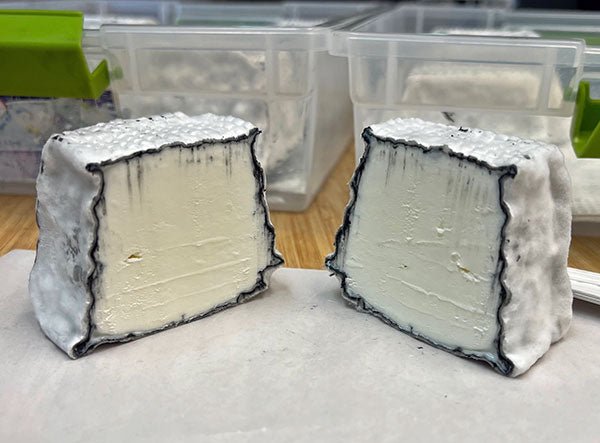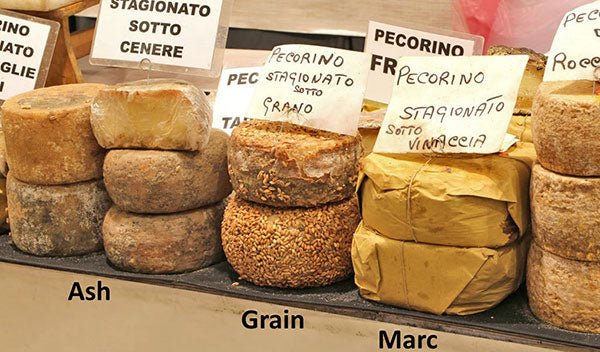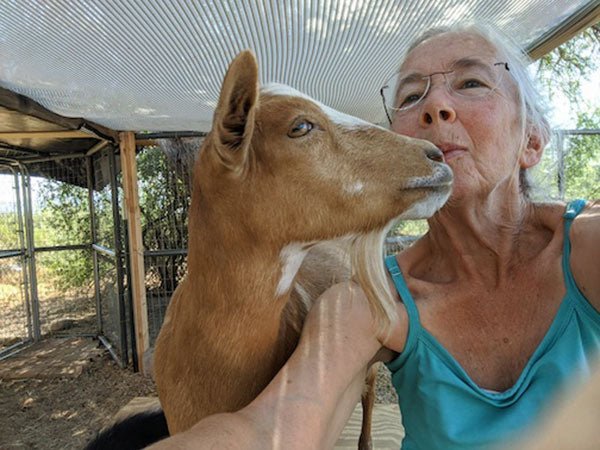We interviewed Marybeth Bullington of Elfin Acres in Creswell, Oregon recently (click here). Marybeth gets a LOT of fresh, raw milk from her 50 +/- Nigerian Dwarf goats. Valencay is her favorite cheese, although she loves all the “fuzzy, delectable little cheeses.”
Regarding this article, she told us:
I have been pondering the arrogance of me teaching cheesaphiles about creating the mysterious Valencay. I’m feeling rather like an imposter since I don’t check PH and only ‘kind of’ follow the instructions. I just make cheese.
However, I guess trying to de-mystify the process for others is a worthwhile goal. My casual approach follows through with my original premise of how cheese came about – the vast array of cheese in the world is the result of experimentation based on local supply and conditions.
The creators of these magical transformations of milk into cheese had no thermometers, pH strips, etc. They kept at it, building on each success for their locale. True, a recipe cuts this trial and error sequence down, but one should be open to minor variations that make a cheese “yours.”
There is certain joy in preserving food for an uncertain future.
Marybeth’s Valencay
Based on recipe by Debra Amrein-Boyes in 200 Easy Homemade Cheese Recipes Filter 20 lbs. (2.3 gallons) of fresh, raw goat’s milk into a sanitized stainless steel bucket. (Note: Dairy folks measure milk in pounds not volume.)
Heat to 72F and remove from heat.
Add:
Mesophilic culture, 1/2 teaspoon
Geotrichum Candidum, pinch
Penicillium Candidum, pinch
Add:
Calcium chloride, 1/4 teaspoon diluted in 1/4 cup cool water
Rennet, 1/4 teaspoon diluted in 1/4 cup cool water
Cover and let the milk meditate for 18 to 24 hours.
Get out your drain trays and Valencay molds. (Note: I use the handy broiler pans for draining! They are perfect and never rust.)
Remove the whey as you go, using a turkey baster. An extra mold can be partly submerged in the whey to keep the curds out of your baster. Keep filling the forms until they are heaped high!
After setting for an hour or so:
And now we wait! Our cheesy friends need to meditate for 48 hours or so before they begin their next transformation.
Note: Getting to the final white mold transformation and on to the gooey stage will take a while. Well worth the wait though.
This was prep school for the young and impressionable Valencay pyramids.
The next stage:
At this point, they have been left in their molds for 48 hours, undisturbed.
Since the next two stages are somewhat messy, line the work surface with plastic wrap.
Tip the cheeses out of their molds and sprinkle all sides with cheese salt or kosher salt (about 2 tablespoons, altogether). Due to their fragile nature, I find it best to tip them from one ‘face’ to another rather than picking them up.
After salting, replace them in the molds and let them rest (and sweat) for 15 minutes or so.
While they are enjoying a little nap, get your aging containers ready. (I use plastic containers with air holes punched in the lids.)
First, put down multiple layers of paper towels so your little cheesy friends don’t have to swim.
Next, add TWO layers of stiff plastic matting. Again, this is necessary to keep the cheeses from drowning. (Your mats should have the corners snipped off so you can easily change the paper towels when they are sodden.)
Ashing:
I use pure culinary vegetable ash (but you can use any food-grade ash).
The cheeses will have lost a bit of moisture, so put some additional plastic wrap down for a dry work surface.
Put on your gloves and get out a fine sieve and a small spoon to put more ash into the sieve as needed. Again, you will be ‘rolling’ the cheese to expose the various surfaces to the ash from the sieve.
Note a couple of things:
* You only need a fine layer of ash.
* Use one hand to move the cheese while keeping the other dry and clean to refill the sieve.
* Don’t touch anything with the ‘cheese’ hand or it will be black for a long time.
* For the last few cheeses, you can probably just roll over the plastic surface and accumulate enough ash.
Place the cheese in your containers with at least a ½ inch clearance. When their fuzzy coats begin to grow, you don’t want them to mingle.
Monitor the cheese daily. Be sure the container has plenty of air circulation. You may need to use a couple of chopsticks to elevate the lid for additional air movement. (You may even subject them to the breeze from a tiny fan to help them dry a bit.)
If there is condensation on the sides of the container, wipe it off. If the papers towels are wet, lift the cheeses out using the double mats, wipe the container dry and put down fresh paper towels and replace the cheeses.
Periodically, when changing their ‘diapers,’ lift the cheeses gently so they don’t grow into the matting. If desired, they can be laid on a different side each time you visit them.
And now you wait. Mold growth will take a week or so. The cheese will transform from black to white again.
Then, one day, their fuzzy coats will totally enchant you!
Picking them up at this stage creates feelings of nurturing! The fuzzy mold is soft and reminiscent of very fine fur. Cheesemakers have been known to start talking to their cheese. (Sometimes in the same manner as their other household pets.)
I prefer to leave the cheeses together in their container so I can monitor their progress. Another method is to wrap them in cheese paper to age them. For me, they are too adorable to hide.
I generally make a lot of these at once. Constant quality control is necessary once they start to soften.
If you have a cool place in your house, it could be your Valencays perfect hideaway. How about that extra shelf in the linen closet? Check the temperatures here and there in the house for a place that holds at 55 – 65F. They will age nicely at the traditional 55F, but it takes a bit more time. (Who wants to wait that long?) Wrapping the cheese at this point in aging allows for snuggling them into a smaller container.
When perfection is reached, the center will be soft and runny, the ash-coated exterior will, of course, have a little ‘grit’ for contrast.
Once you have added Valencay to your cheese repertoire, the sky is the limit. It encourages one to be adventurous.
































































































































































